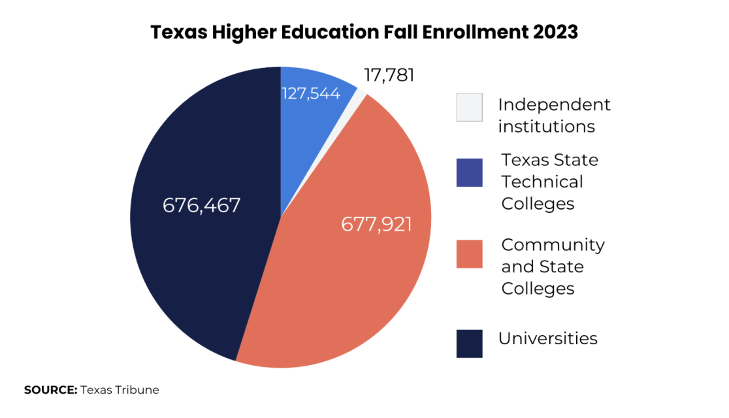In September 2022, I wrote about the Texas Commission on Community College Finance’s (TCCCF) recommendation to increase state and local funding for Texas Community Colleges. The state’s share of funding had decreased from 68% to 26% over the past 40 years, with the difference covered by higher tuition and property taxes. The nonpartisan public policy think tank Texas 2036 supported the recommendation.
It’s no secret that U.S. community colleges educate more students than any other higher education sector. Texas community colleges are no different. The key reasons for large numbers of enrollments are:
- Affordability. Community college tuition in many states is nearly $0 per year.
- Accessibility. Many community colleges have open enrollment policies, admitting nearly everyone who applies.
- Wide range of programs. Offerings at community colleges range from non-credit courses, short-term technical and vocational certificates, and workforce development programs to associate degrees and some bachelor’s degree programs.
- Dual enrollment programs. In some states, more than 20% of community college students are also enrolled in high school earning high school and college credits.
At the time of the proposal, Texas’ budget surplus was $27 billion, and the proposed increase was $650 million over a two-year period.
Texas House Bill 8
In June 2023, I wrote about the Texas Higher Education Coordinating Board’s support of Texas House Bill 8, which, when passed and signed into law, overhauled the funding methodology for community colleges. The bill included incentives to increase enrollments and completions, totaling an incremental $683 million in budget funding.
Texas 2036 supports educational initiatives that will enable its citizens to improve the future competitiveness of Texas. It names the HB 8 legislation mentioned above as a generational investment.
A portion ($125 million) of the incremental HB 8 funding was invested in the Texas Education Opportunity Grant program, the state’s need-based financial aid program for community college students. This additional money will increase the percentage of students able to receive aid from 28% to 70%, a major shift in funding.
An additional $78.6 million was dedicated to financial aid for low-income high school students who want to take a dual credit course.
There are four metrics in HB 8 that define the state’s educational outcomes priorities. These are:
- Credential of Value Attainment. This measures whether the wages of those who earn a credential are higher than the cost of a credential and the average earnings of someone who graduated from high school.
- Credential of Value Attainment in a High-Demand Field. This metric provides bonus incentives for credentials of value in a high-demand field. The metric will be updated regularly using job growth and wage levels.
- Successful Transfer to a Four-Year University. This metric rewards community colleges for students who transfer to a four-year university after earning at least 15 semester credit hours at a community college.
- Dual Credit Completion. This metric recognizes high school students who have completed at least 15 semester credit hours of dual credit.
These four metrics make up the Performance Tier formula, which accounts for more than 90% of the state funding awarded to community colleges. The remainder of the funding is through the Base Tier for community colleges whose tax bases and students served do not generate enough revenues through property taxes and tuition.
The Texas 2036 initiative recently distributed an update about Texas community colleges. Since Texas is the second largest state in population (29 million), I thought listing a few of the highlights singled out would be worthwhile.
Texas Community Colleges Today
Texas organizes its community colleges into 50 community college districts. Some are named after the community college serving the area, such as Austin Community College. Others are named as districts, such as the Alamo Colleges District.
Approximately 678,000 students enrolled in Texas community colleges last fall. Enrollment peaked at 747,000 students in 2019, before the pandemic. See the chart below for a Fall 2023 enrollment chart by institution type in Texas.

Community college enrollments range from 76,000+ at Lone Star College in Houston to 1,400 at the Clarendon College system, 60 miles east of Amarillo in the Texas Panhandle. Like everyone else in the U.S., Texas administrators are waiting to see if the FAFSA debacle impacted Fall 2024 enrollment.
It’s no surprise that Texas community colleges are the lowest-cost public option in the state. According to the National Center for Education Statistics, the average 2022 in-state cost to attend a public four-year university in Texas was $18,807, while the average 2022 in-state cost to attend a public two-year college in Texas was $2,859.
Approximately 130,000 degrees and certificates were earned at Texas community colleges in 2023. Short-term certificates represented 40,000 of the total earned. More than 7 out of 10 students attended community college part-time in 2023.
More than 170,000 students attended Texas community colleges as dual enrollment students in 2021. This represented approximately 25% of Texas community college students. It will be interesting to see how much the incentives increase this percentage. In fact, 44% of Texas community college students enroll in academic credit programs vs. 31% of students nationwide.
According to THECB, only 34% of full-time community college students graduate in four years, and only 25% transfer to a four-year college or university. Since each of these metrics are included in the performance tier, increasing them will be important.
Adapting to the New Funding Formula
Since the new funding formula rewards colleges for completions, transfers, credentials of value and dual credit, some colleges have offered free tuition to incentivize increased enrollments.
In my city, Austin Community College offered free tuition to all high school graduates of the class of 2024 who enrolled this fall. This group was selected because data indicate that 57% of all Austin-area high school graduates did not enroll in postsecondary education after high school in 2023. The offer was announced as a five-year pilot.
Austin CC announced that it is working to raise funds to expand the program to existing students. It will be interesting to see how much fall 2024 enrollments increase based on the announcement of this program.
In Corpus Christi, Del Mar College announced that local high school students will have no charge for dual enrollment credit classes this year. Previously, Del Mar was charging local students $33 per credit hour to take the dual credit courses. Now, the state will pay the college $55 per credit hour. The funding change is expected to make a difference.
The Texas Association of Community Colleges has developed a pathway map for colleges to offer programs like phlebotomy leading to future cardiovascular technologists and technicians. The starter occupations are phlebotomists and pharmacy technicians who can acquire EKG/ECG, Stress testing, and Catheterization Laboratory skills, enabling a boost in earnings.
In turn, cardiovascular technologists and technicians can acquire skills in ultrasound, radiology patient positioning, computed tomography, diagnostic imaging, and patient safety, leading to occupations such as diagnostic medical sonographers, magnetic resonance imaging technologists, and radiologic technologists with boosts in earnings.
Texas Association of Community Colleges Summer Meeting
In his keynote speech to the delegates at this summer’s Texas Association of Community College’s meeting, Texas 2036 President and CEO David Leebron stated that community colleges “are the workforce engines of the 21st century.” Leebron transitioned this summer to his new CEO role at Texas 2036 from his former job as president of Rice University.
Leebron told the assembled group that Texas 2036 is planning to work with the legislature in this year’s upcoming session to see that the funding reforms in HB 8 continue to be funded. They believe that the “credential of value” measurement is particularly important to enable community college graduates to sustain their families through their earnings.
CEO Lebron also noted that community colleges have an important role in modernizing secondary schools through their commitment to dual credit programs, which can lead to career-aligned credentials of value in a high school setting.
Leebron’s remarks were echoed in the association’s three-day agenda. Topics like credentials of value, workforce data, workforce and education partnerships, dual credit partnerships, the impact of AI on higher education, and the political landscape were clearly focused on focusing the group on areas of advancement.
Other Texas Legislation Aligned With HB 8
While HB 8 received much press and accolades for its increased funding to community colleges, the Texas 2036 website highlights other legislation proposed and passed by the 88th Legislature. These initiatives included:
- Advanced Math Pathways – Requires districts to offer advanced math classes for high achieving middle school students regardless of their background or geographic location.
- High-Quality Tutoring – Ensures that tutoring remains in place to assist students impacted by the pandemic.
- College, Career, and Military Readiness Study – Requires TEA to study post-secondary outcomes of students and how they correlate to student programming in high school.
- Rural Pathways Excellence Partnership – Expands options for rural school districts to provide college and career pathways that lead to post-secondary success and earning a family-sustaining wage in their hometown.
- Workforce Data Modernization — Provides the state with data to ensure that taxpayer-funded workforce development programs provide participants an ROI.
- Apprenticeship Reporting – Establishes data and analysis needed to expand apprenticeships in emerging and high-demand industries.
- Workforce Development Funding – Creates the Lonestar Workforce of the Future Fund with $5 million to provide Texans with the skills needed to earn a job with a family-sustaining wage.
- Adult Student Recovery – Provides adult students an opportunity to concurrently earn a high school diploma and a workforce-aligned postsecondary credential.
- Apprenticeship Funding Coordination – Streamlines and eliminates administrative barriers for apprenticeship and other workforce learning providers to increase the availability of such programs throughout Texas.
Will the Boost in HB 8 Funding Make a Difference?

I believe the HB 8 funding boost is already making a difference. I don’t think Austin Community College would have offered its free tuition program to area Class of 24 high school graduates without it. I also believe that Del Mar College may not have offered free dual enrollment classes to its local high school students without it.
Texas is well-known for its data-tracking systems. In early 2021, I wrote about the data reporting tools used by Texas 2036 to track workforce outcomes. In 2022, I wrote about the Texas Higher Education Coordinating Board’s (THECB) tracking of student loan debt for its 60X30TX strategic plan.
In my overview of the THECB debt metrics, I wrote the following: “Texas expects its publicly funded institutions to be affordable. It also expects them to provide programs that are marketable to employers. It expects them to provide pathways and advising for quicker times to completion.”
Texas 2036 and THECB will track the outcomes of the four major metrics comprising the Performance Tier in the new community college funding formula. The trickiest part will be examining all the workforce programs offered by Texas community colleges (approximately one-third of all Texas community college students participate in non-credit workforce programs) and classifying the credential as a credential of value or a credential of value in a high-demand field.
The Federal Reserve Bank of Dallas has posted an interesting article about workforce development initiatives at Texas community colleges. The article tells a specific story about an Austin Community College partnership with Samsung that began as a non-credit initiative to meet the company’s needs quickly rather than go through state and accrediting agency approval.
I wonder how many colleges have similar experiences of finding ways to avoid their accrediting agency in order to bring a program to market quicker (likely the basis for a future article).
The state of Texas collects data and is not afraid to publish it. Clearly, there is an ethos that believes in the mantra, “If you can’t measure it, you can’t improve it.” Community colleges are the melting pot of higher education, providing non-credit and credit credentials at affordable prices and open access to many of those programs.
The biggest potential hiccup in this new funding formula will be the definition and measurement of credentials of value. The major metropolitan areas of Texas are hiring people for jobs in fast-food establishments at $20/hour (or more) wages.
Wages for high school graduates may be greater than some of the credentials of value. In that case, the program will either die on the vine or must be modified. In the long run, that type of analysis should result in better programs.











